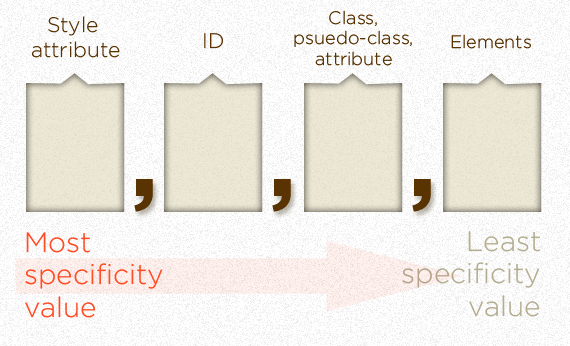CSS Specificity
Specificity is a great tool to manage the power of CSS but can be complicated. As we will see, not all selectors are equal in “power”:
- If there are two or more rules that apply to an element, the most specific selector is used
- If the two rules have equal specificity, then the latest rule is applied
Let’s check this example. Which one is more important?
li {
color:green;
}
li.special {
color:red;
}
What about now?
li#special {
color:green;
}
li.special {
color:red;
}
How does it works
- Specificity determines, which CSS rule is applied by the browsers
- Specificity is usually the reason why your CSS-rules don’t apply to some elements, although you think they should
- Every selector has its place in the specificity hierarchy
- If two selectors apply to the same element, the one with higher specificity wins.
- There are four distinct categories which define the specificity level of a given selector: inline styles, IDs, classes, attributes, and elements
- When selectors have an equal specificity value, the latest rule is the one that counts
- When selectors have an unequal specificity value, the more specific rule is the one that counts
- Rules with more specific selectors have a greater specificity
- The last rule defined overrides any previous, conflicting rules
- The embedded style sheet has a greater specificity than other rules
- ID selectors have a higher specificity than attribute selectors
- You should always try to use IDs to increase the specificity
- A class selector beats any number of element selectors
- The universal selector and inherited selectors have a specificity of 0, 0, 0, 0
Let’s take a look at how the numbers are actually calculated:

- If the element has inline styling, that automatically1 wins (1,0,0,0 points)
- For each ID value, apply 0,1,0,0 points
- For each class value (or pseudo-class or attribute selector), apply 0,0,1,0 points
- For each element reference, apply 0,0,0,1 point
You can generally read the values as if they were just a number, like 1,0,0,0 is “1000”, and so clearly wins over a specificity of 0,1,0,0 or “100”. The commas are there to remind us that this isn’t really a “base 10” system, in that you could technically have a specificity value of like 0,1,13,4 - and that “13” doesn’t spill over like a base 10 system would.
Let’s see some very good examples
Pseudo-classes and pseudo-elements
What are Pseudo-classes?
A pseudo-class is used to define a special state of an element. For example, it can be used to:
- Style an element when a user mouses over it
- Style visited and unvisited links differently
- Style an element when it gets focus
Syntax
selector:pseudo-class {
property: value;
}
A common example: Anchor Pseudo-classes
- Unvisited: a:link
- Visited: a:visited
- Mouse Over: a:hover
- Selected: a:active
A few CSS Pseudo Classes
| Selector | Example | Description |
|---|---|---|
| :active | a:active | Selects the active link |
| :checked | input:checked | Selects every checked <input> element |
| :enabled | input:enabled | Selects every enabled <input> element |
| :disabled | input:disabled | Selects every disabled <input> element |
| :focus | input:focus | Selects the <input> element that has focus |
| :hover | a:hover | Selects links on mouse over |
| :in-range | input:in-range | Selects <input> elements with a value within a specified range |
| :invalid | input:invalid | Selects all <input> elements with an invalid value |
| :first-child | p:first-child | Selects every <p> elements that is the first child of its parent |
| :last-child | p:last-child | Selects every <p> elements that is the last child of its parent |
What are Pseudo-Elements?
A CSS pseudo-element is used to style specified parts of an element. For example, it can be used to:
- Style the first letter, or line, of an element
- Insert content before, or after, the content of an element
Notice the double colon notation - ::first-line versus :first-line
The double colon replaced the single-colon notation for pseudo-elements in CSS3. This was an attempt from W3C to distinguish between pseudo-classes and pseudo-elements. The single-colon syntax was used for both pseudo-classes and pseudo-elements in CSS2 and CSS1.
The ::after Pseudo-element
The ::after pseudo-element can be used to insert some content after the content of an element. The ::before pseudo-element insert the content before the element. Obviously.
Learn more
- W3Schools: Pseudo-classes
- W3Schools: Pseudo-elements
- CSS-Tricks: A Whole Bunch of Amazing Stuff Pseudo Elements Can Do
- CSS-Tricks: Glyphs
- W3Schools: CSS Specificity
- CSS Tricks: Specifics on CSS Specificity
- Smashing Magazine: CSS Specificity Things You Should Know